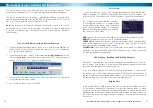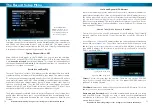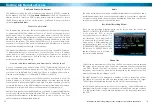
Troubleshooting
Problem:
My DVR does not switch on.
Solution:
Make sure you have plugged in the power supply (12V) to the DVR and
into the wall socket. Carefully check the integrity of the connections. Check the
master switch on the back of the unit. Try another power socket.
Problem:
My display is showing “NO HARD DISK” when I press record.
Solution:
If you have recently changed the hard drive in your DVR unit make sure
it is plugged in properly; otherwise the hard drive may be faulty. Try connecting
another (working) hard drive to the DVR; if this still doesn’t work then the DVR
maybe faulty. We suggest calling Swann Technical Support - the contact information
is on the rear cover of this booklet.
Problem:
I am not getting picture on any of my displays.
Solution:
Make sure the cameras are connected properly to the DVR and the
power supply (12V 1A). Check that the cables are not faulty by connecting the
cameras directly to the DVR or to a TV (if you have the proper adapters).
Problem:
One of the displays is not showing on my screen.
Solution:
Make sure all cameras are set to ON in CAMERA SETUP. Check the
integrity of your cables and connections. Check the power supply to the camera.
Try attaching another channel to the questionable input.
Problem:
I cannot login to my DVR remotely using the NetViewer software or the
Internet Explorer browser.
Solution:
Make sure you have confi gured the IP, ActiveX and USER SETUP correctly.
Remember the USER PASSWORD may be different to the ADMIN PASSWORD. The
ADMIN PASSWORD is used to login to the DVR remotely.
Problem:
I cannot perform a backup.
Solution:
Make sure the DVR is connected to a USB fl ash drive, and that the USB
fl ash drive is formatted to have a FAT32 fi le system.
64
5
Read Before Installation
IMPORTANT GUIDELINES
Do not expose the DVR to moisture
•
. Water is the arch-enemy of electrical
components and also poses a high risk of electric shock.
Avoid dusty locations
•
. Dust has a tendency to build up inside the DVR case,
leading to a high risk of failure or even fi re.
Only install the DVR in a well ventilated space
•
. The circuitry and hard
drive in the DVR produces a signifi cant amount of heat, and this heat needs
a way out.
Do not open the DVR case
•
except to install/swap the hard drive inside. There
are no user serviceable parts inside.
Never open the case whilst the DVR is plugged in
•
, and never turn the
DVR on whilst the case is open.
Use only the supplied power adaptor.
•
Other adaptors may cause damage
to the DVR or cause a fi re.
Do not cut or modify any cable for any reason.
•
Doing so will void your
warranty, as well as pose a great risk of fi re or electrical shock.
Don’t expose the DVR to sudden bumps or shocks
•
(for example, being
dropped). The DVR is as robust as possible, but many of the internal components
are quite fragile.
Remember that the DVR is, in all likelihood, going to be left on 24 hours a day,
•
7 days a week. Keep this in mind when choosing a location for installation.
IMPORTANT: Do not pull, tug, sharply bend or twist the I/O Cable.
For your convenience, the DVR features an I/O (Input/Output) cable, through which
all your cameras and other devices (such as microphones or PTZ systems) can be
connected.
Like many complex cables used to transmit audio/visual information, it’s made up
of many thin copper cables, each used to carry part of the signal. Rough treatment,
twisting or sharply bending the cable can cause small cracks in the copper cabling,
which will reduce the quality of your images.






































